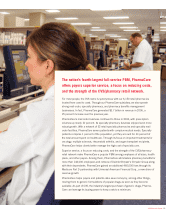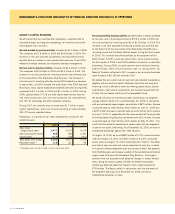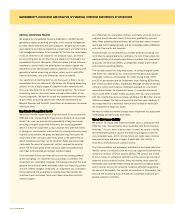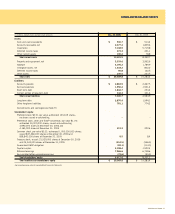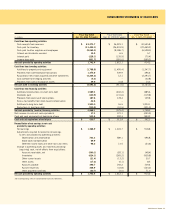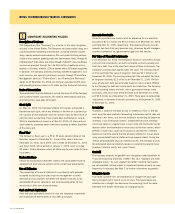CVS 2006 Annual Report Download - page 27
Download and view the complete annual report
Please find page 27 of the 2006 CVS annual report below. You can navigate through the pages in the report by either clicking on the pages listed below, or by using the keyword search tool below to find specific information within the annual report.
MANAGEMENT’S DISCUSSION AND ANALYSIS OF FINANCIAL CONDITION AND RESULTS OF OPERATIONS
24 CVS Corporation
CRITICAL ACCOUNTING POLICIES
We prepare our consolidated financial statements in conformity with
generally accepted accounting principles, which require management
to make certain estimates and apply judgment. We base our estimates
and judgments on historical experience, current trends and other factors
that management believes to be important at the time the consolidated
financial statements are prepared. On a regular basis, we review
our accounting policies and how they are applied and disclosed in our
consolidated financial statements. While we believe that the historical
experience, current trends and other factors considered support the
preparation of our consolidated financial statements in conformity with
generally accepted accounting principles, actual results could differ
from our estimates, and such differences could be material.
Our significant accounting policies are discussed in Note 1 to our
consolidated financial statements. We believe the following accounting
policies include a higher degree of judgment and/or complexity and,
thus, are considered to be critical accounting policies. The critical
accounting policies discussed below are applicable to both of our
business segments. We have discussed the development and selection
of our critical accounting policies with the Audit Committee of our
Board of Directors and the Audit Committee has reviewed our disclosures
relating to them.
Impairment of Long-Lived Assets
We account for the impairment of long-lived assets in accordance with
SFAS No. 144, “Accounting for Impairment or Disposal of Long-Lived
Assets.” As such, we evaluate the recoverability of long-lived assets,
including intangible assets with finite lives, but excluding goodwill,
which is tested for impairment using a separate test, whenever events
or changes in circumstances indicate that the carrying value of an asset
may not be recoverable. We group and evaluate long-lived assets for
impairment at the individual store level, which is the lowest level at
which individual cash flows can be identified. When evaluating long-
lived assets for potential impairment, we first compare the carrying
amount of the asset group to the individual store’s estimated future
cash flows (undiscounted and without interest charges).
If the estimated future cash flows are less than the carrying amount
of the asset group, an impairment loss calculation is prepared. The
impairment loss calculation compares the carrying amount of the asset
group to the individual store’s estimated future cash flows (discounted
and with interest charges). If required, an impairment loss is recorded
for the portion of the asset group’s carrying value that exceeds the
individual store’s estimated future cash flows (discounted and with
interest charges).
Our impairment loss calculation contains uncertainty since we must use
judgment to estimate each store’s future sales, profitability and cash
flows. When preparing these estimates, we consider each store’s historical
results and current operating trends and our consolidated sales, profitability
and cash flow results and forecasts.
These estimates can be affected by a number of factors including, but
not limited to, general economic conditions, the cost of real estate, the
continued efforts of third party organizations to reduce their prescription
drug costs, the continued efforts of competitors to gain market share
and consumer spending patterns.
The net book value of our long-lived assets, including intangible assets
with finite lives, covered by this critical accounting policy was approxi-
mately $6.7 billion as of December 30, 2006. During 2006, 2005
and 2004, we recorded pre-tax impairment losses totaling $28 million,
$27 million and $20 million, respectively. Although we believe we have
sufficient current and historical information available to us to record
reasonable estimates for impairment losses, it is possible that actual
results could differ. In order to help you assess the risk, if any, associated
with the uncertainties discussed above, we believe the $8 million pre-tax
difference between the high and low end of the three-year impairment
loss range would be a reasonably likely annual increase or decrease in
the impairment of long-lived assets.
We have not made any material changes to our impairment loss assessment
methodology during the past three years.
Closed Store Lease Liability
We account for closed store lease termination costs in accordance with
SFAS No. 146, “Accounting for Costs Associated with Exit or Disposal
Activities.” As such, when a leased store is closed, we record a liability
for the estimated present value of the remaining obligation under the
non-cancelable lease, which includes future real estate taxes, common
area maintenance and other charges, if applicable. The liability is
reduced by estimated future sublease income.
The initial calculation and subsequent evaluations of our closed store lease
liability contains uncertainty since we must use judgment to estimate the
timing and duration of future vacancy periods, the amount and timing
of future lump sum settlement payments and the amount and timing of
potential future sublease income. When estimating these potential
termination costs and their related timing, we consider a number of factors,
which include, but are not limited to, historical settlement experience,
the owner of the property, the location and condition of the property, the
terms of the underlying lease, the specific marketplace demand and
general economic conditions.



